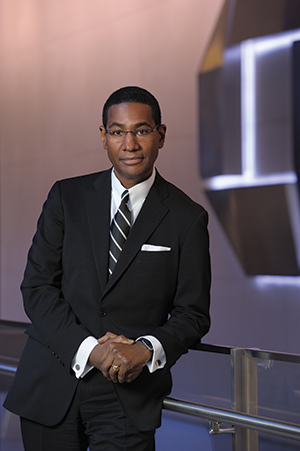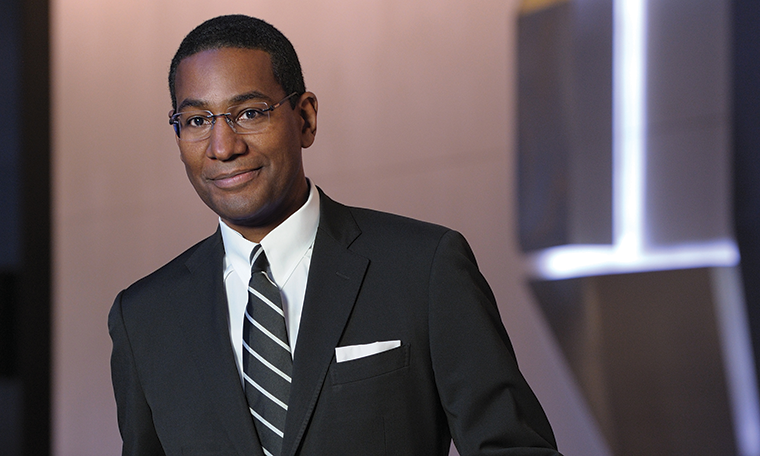A self-proclaimed “accidental CLO,” Jesse Jackson has served in numerous roles at the multinational banking and financial services firm JPMorgan Chase & Co. After completing five years of active duty in the U.S. Navy, he joined the bank’s management development program more than 25 years ago, starting as a teller and a banker. He eventually moved on to consumer banking management roles such as sales manager, branch manager and division sales manager.
Jackson said his career path has been opportunistic. “It’s about crushing the job that you’re doing very effectively and performing as well as possible, and as a result, other opportunities will open,” he said. “As jobs are being destroyed, new jobs are being created. Individuals should not necessarily be focused on a set of jobs as opposed to a set of skill sets and attributes needed to perform effectively.”
About four years ago, Jackson moved into his current role as CLO of consumer and community banking. Because he has spent so much time in the business, Jackson said he can truly understand the tactical elements of the various internal jobs while simultaneously understanding the customers’ needs and wants.
“It has allowed me to think differently in terms of the value I bring to the role,” he said. “Anyone who spends time in the different business functions — who has that type of intimacy around what people are doing to support the customer and what the customer is looking for — has an ability to bring value into a CLO role that’s focused on shaping skills, behavior and knowledge of employees to meet those needs and goals.”
Matt Condon, managing director of consumer and community banking learning at JPMorgan Chase, said Jackson has brought focused leadership and a sharp ability to execute key priorities in each of his roles and now brings those skills into the business of learning.
“I think Jesse would be successful in any position to which he fully commits — it’s who he is,” Condon said. Jackson has a broad perspective and is adept at considering multifaceted approaches to his work, Condon said, yet he does so in a way that makes it sustainable.

A Singular Approach
Jackson oversees the community bank L&D department with 700 full-time employees. It is structured around centers of excellence that are core to delivering value to internal learners: digital learning solutions, operations, platform and learning programs and controls.
As CLO, Jackson is responsible for strategy and execution of the learning approach and delivery across the enterprise. In this role, he implemented a new learning management system to replace three separate systems that management felt lacked scale and ability to adapt with employees.
“Our senior leadership recognized the ability to unlock value by bringing together learning groups, really beginning to think about how to roll that up in a way that delivers a more harmonized best-in-class practice as we think about our customers’ expectations through a more singular lens,” Jackson said.
Condon said in just three years Jackson was able to successfully pull together the many training functions into one high-performing learning organization. “He structured the organization in a way that brought high quality at a much lower cost,” Condon said. “He has anticipated the needs of our learners and demonstrated a tireless effort to hire and grow the right talent to be able to provide learning experiences to our employees that are rare in the industry.”
The Business of Learning
Jackson approaches each new challenge with a philosophy that ensures employee efficiency, which he sums up as “the business of learning.” He aims to understand what behaviors contribute to high-potential performance and then develops learning assets to optimize that performance. The key is doing so not as an event but as a continuum of experiences over the course of each employee’s longevity, he said.
As he navigates the digital learning journey at Chase, Jackson said this philosophy has helped provide clarity to employees in leadership development programs on how they can progress in their careers.
“We have a hire-to-retire mentality where we ensure that annually we’re building learning paths and calendars to allow us to move employees through a cadence of learning that helps us enhance their proficiency through changes,” he said. “We help employees get in front of and understand behavioral changes to perform effectively in the face of that change.”

As part of the digital journey, Chase has been ramping up mobile learning. In 2017, the firm built a mobile application, Learning at JPMC, so employees can access the LMS and consume training on the go.
With the workforce rapidly becoming a millennial majority, Jackson said engaging the digitally native generation has accelerated the maturity of their digital direct learning strategy. “[Millennials] are used to having self-directed learning paths and being engaged via virtual instructors,” he said. Engaging this workforce has prompted Chase to use video and other capabilities to allow senior leaders to speak to individuals remotely.
Condon said Jackson is fully reimagining how to deliver training when and where employees want it. “Under Jesse’s leadership, we have accelerated the development of high-quality digital learning solutions to provide low-cost and highly flexible delivery paths while also supporting the standardization of best-in-class learning principles,” he said.
Executive Director of JPMC Learning Alexandra Scoulas said Jackson is a technologically savvy person and they often race to see who is going to get the latest gadget. Scoulas said Jackson, a consumer himself, is effective at translating what people want in terms of digital learning.
“He’s not just leading the business, but pushing them forward — leading as well as responding to what they want,” she said. “He has championed the fact that we have the opportunity to deliver in so many different modalities and he has been blessed with having some business leaders come on the scene in the last year and a half who are anxious to move us out of the classroom and integrate more informal learning.”
https://youtu.be/Amsub4nYLqM
Going Digital, Getting Results
One challenge Jackson and his team have faced is improving the employee learning experience associated with Chase’s regulatory training agenda.
“An assumption we’ve made as a firm is that everyone needs to take certain programs every year,” Jackson said. “But as we think about the learning comprehension and capabilities of our experienced employees, maybe that’s not really true.”
To help address this situation, Jackson’s team incorporated “test-outs” that allow them to test employees before they take a course. Jackson said a lot of individuals with significant tenure can pass the test-outs, so they shouldn’t have to spend their time completing a course they don’t need. They also bundled classes that have similar concepts.
Although test-outs and bundling are not unique to Chase across the learning landscape, Scoulas said Jackson was an early adopter. “Being able to test out instead of taking the course really gets to the heart of the matter,” she said. “Our goal is to ensure employees are equipped to do their work. The end goal isn’t having them take the training, the end goal is having them know what they need to know.”
As learning at Chase is becoming more digital, so is the banking world in general, with more services shifting online. With that change, Jackson said the role of learning becomes more complex. The types of questions that employees might get asked by customers are changing — questions about issues with their devices or the operating systems they are using to view their bill, for example.
“We see the value curve really going up in terms of our ability to deliver more complexity and more understanding,” Jackson said. “It reinforces the idea that you can’t do it in a classroom. We need to ensure that we’re preparing people to access information and then making that information available to them.”
Jackson said the ultimate measure of success of all these efforts is age-old metrics around employee engagement, employee retention and employee mobility. “While we have a very disciplined learning agenda, we’re able to deliver differentiated value,” he said.
Jackson points to employee retention and engagement as defining metrics, particularly when working with millennials, who are often stereotyped as job-hoppers. “Our metrics suggest we are among the best in class in terms of being able to deliver those capabilities and, as a result, those metrics to our business and ultimately to our customers,” he said.
Because Jackson’s team is focused on the business of learning, they ensure they are training against key performance indexes, Jackson said. “We are measuring performance with respect to service and sales of employees who have moved through our training programs versus employees who have not moved through those programs to ensure they are having the intended effect,” he said.
Jackson said they leverage the same business metrics that measure employee success to help them understand, tailor and calibrate the effectiveness of their program. “We have robust scorecards across our enterprise in terms of how we measure conventional learning, but [we] also try to ensure that those learning measures are evidencing our obligation to increase organizational performance via our people,” he said.

The Future of Learning at Chase
Looking ahead, Jackson wants to incorporate emerging technologies more fully into learning, specifically by personalizing learning delivery to leverage employee intimacy.
“We know the job family, we know the years of service, we know their performance rating, we know what training they’ve been to,” he said. “We really want to be able to be more predictive in terms of recommending the type of learning path to employees that we believe is going to enhance their performance, their job and their success at the corporation.”
Jackson said they are studying how to leverage big data to help deliver that type of intelligence to employees. Having one LMS and a singular taxonomy of learning assets across the firm will help, he said.
Jackson wants to ensure that they don’t live in an echo chamber — that Chase is looking at not just what’s happening within the L&D industry but also what’s happening across other industries. For example, they studied Cornell University to understand how it is delivering virtual learning to individuals getting MBAs and they also looked at what Google and Apple are doing to enhance learning at their genius bars and how they engage customers around their product sets.
Within the organization, Jackson says his team can learn from methods like observing how a banker or teller engages a client or putting on headphones at a call center with an agent. “There’s so much more that we can do to incorporate learning and recognize the learning that happens within the workforce as a way to continue to develop talent,” Jackson said.
If the rest of the L&D team is anything like Scoulas, they’ll be glad to continue the digital journey with Jackson. After working closely with Jackson for the past 10 years, Scoulas said she’s found him to be an extremely thoughtful and inspirational leader.
“I wouldn’t have followed him if he wasn’t a great manager,” said Scoulas, who followed Jackson on his path from customer service to business banking to learning. “I have personally grown and developed as a result of his thoughtful, inspiring and sometimes challenging high standards.”















